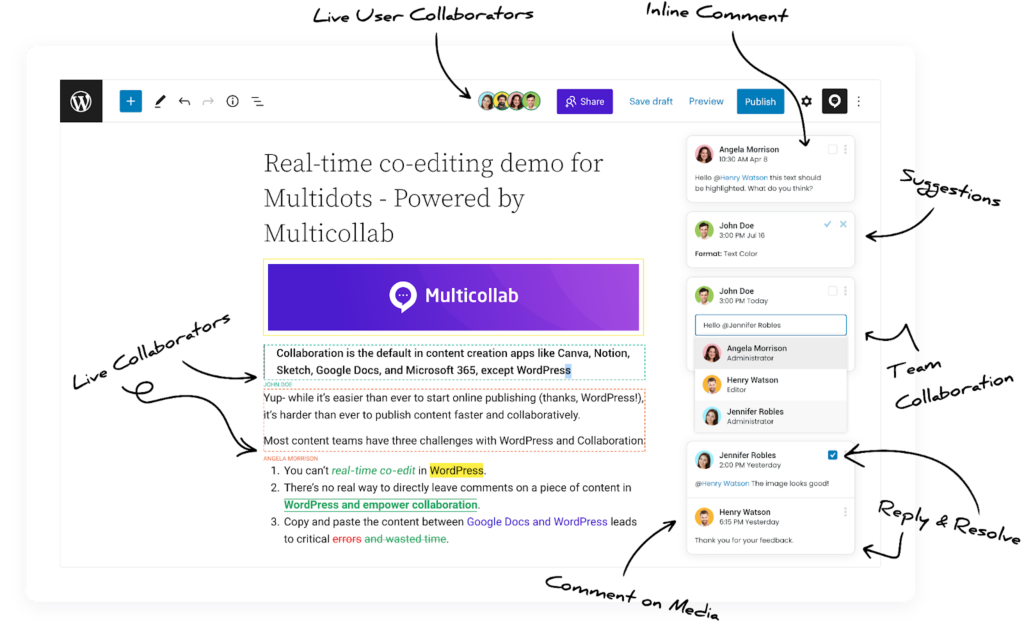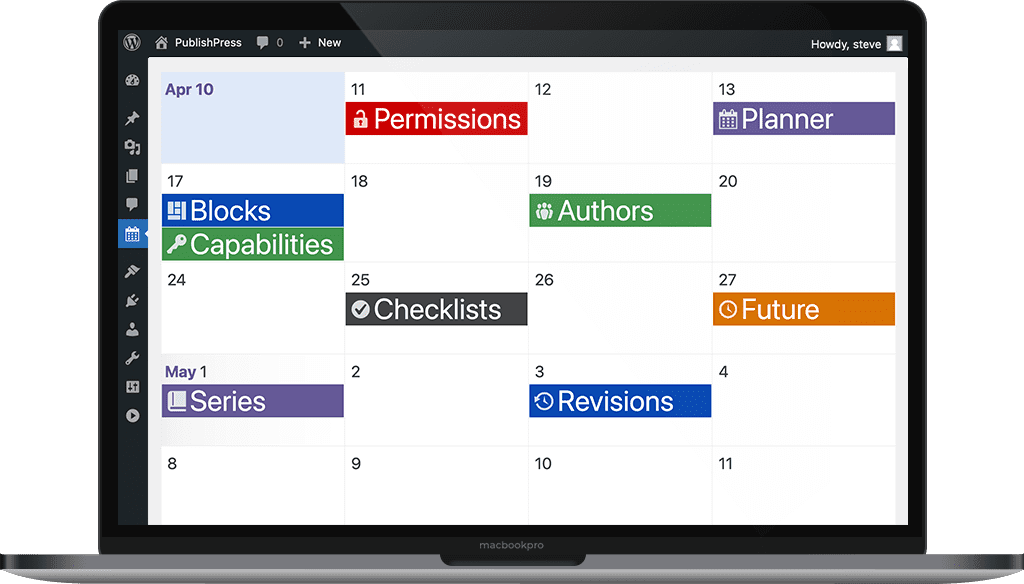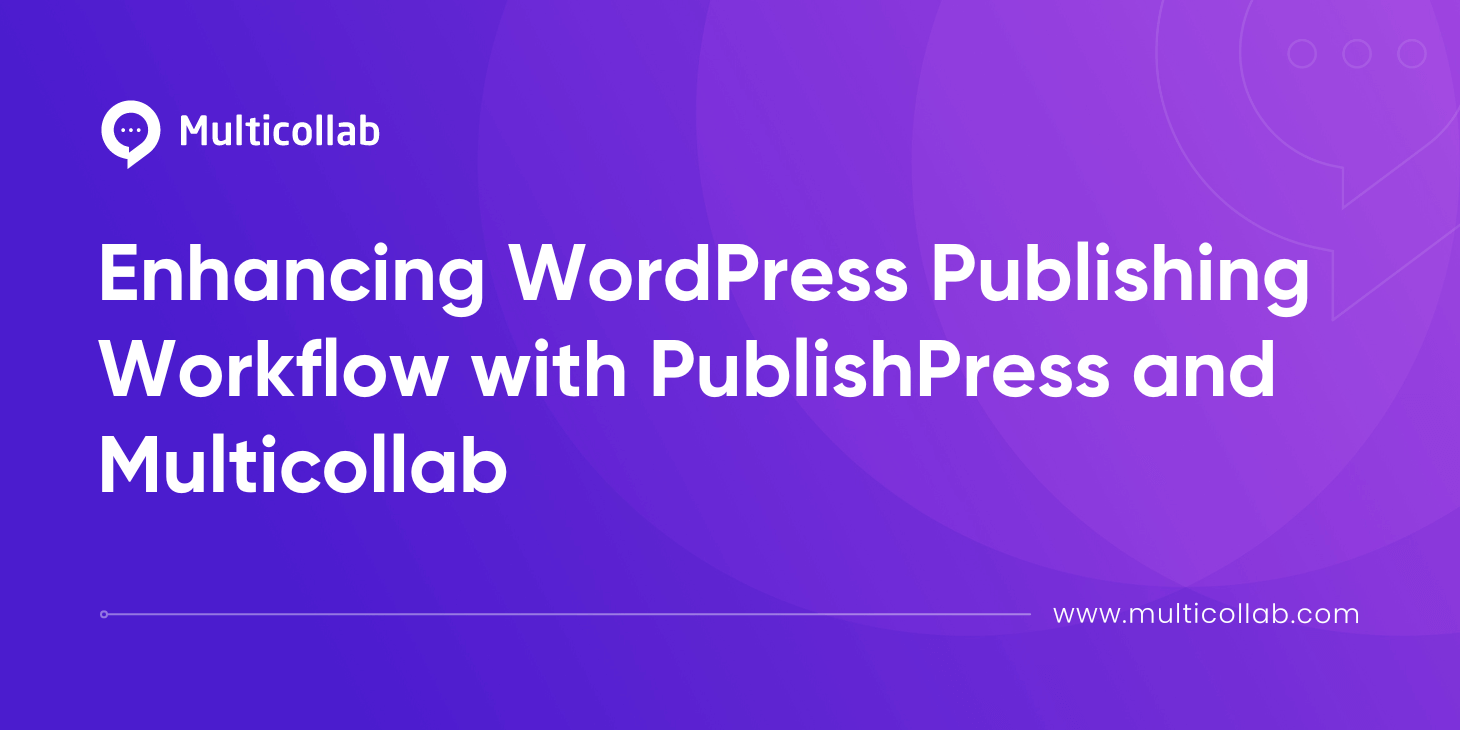Table of Contents
When managing a WordPress site, optimizing your publishing workflow is crucial for maintaining efficiency, productivity, and high-quality content output. This involves more than just writing and publishing posts; it requires strategic planning, role assignment, collaborative content creation, meticulous quality control, and robust scheduling.
A well-structured editorial workflow ensures consistency and helps align content with overarching business goals.
Utilizing powerful tools like Multicollab and PublishPress can streamline these processes, ensuring that every piece of content is created, reviewed, and published seamlessly. This structured approach not only enhances productivity but also ensures that content aligns with overarching business goals, ultimately driving engagement and growth.
In this blog post, we’ll explore how combining PublishPress and Multicollab can transform your WordPress publishing experience. While each plugin brings unique features to the table, using them together can create a seamless and robust publishing environment.
What makes an ideal WordPress publishing workflow?
Lets take a look at all the pre-requisites of an ideal WordPress publishing workflow along with the key elements of each of these.
| Requirement | Key Elements |
| Clear Content Strategy | Editorial Calendar: Plan and schedule content in advance to ensure a consistent publishing schedule. |
| Content Goals: Define clear objectives for each piece of content to align with overall business goals. | |
| Roles and Responsibilities | Defined Roles: Assign specific roles such as writers, editors, designers, and publishers. |
| Responsibilities: Clearly outline the responsibilities for each role to avoid overlaps and ensure accountability. | |
| Content Planning and Ideation | Brainstorming Sessions: Regular meetings to generate content ideas. |
| Content Briefs: Detailed briefs for each piece of content, including target audience, keywords, and objectives. | |
| Content Creation and Collaboration | Real-time Collaboration: Tools that allow multiple users to work on a piece of content simultaneously. |
| Feedback Mechanisms: Easy ways to provide and incorporate feedback, such as inline commenting and suggestion modes. | |
| Quality Control and Review | Checklists: Ensure all necessary tasks (e.g., SEO optimization, proofreading) are completed before publishing. |
| Approval Process: A clear process for reviewing and approving content before it goes live. | |
| Scheduling and Publishing | Editorial Calendar Integration: Schedule posts directly from the editorial calendar. |
| Automation: Automate tasks like social media sharing and post expiry to save time and ensure consistency. | |
| Permissions and Access Control | User Roles: Define user roles and permissions to control who can access and edit different parts of the site. |
| Advanced Permissions: Customize permissions for specific tasks to ensure security and efficiency. | |
| Analytics and Reporting | Performance Tracking: Monitor the performance of published content to understand what works and what doesn’t. |
| Reports: Generate reports to provide insights into the workflow and content effectiveness. | |
| Continuous Improvement | Feedback Loops: Regularly gather feedback from the team to identify bottlenecks and areas for improvement. |
| Workflow Reviews: Periodically review and update the workflow to adapt to changing needs and technologies. | |
| Efficient Tools | Content Management Plugins: Use plugins like PublishPress for managing authors, permissions, and content scheduling. |
| Content Management Plugins: Use plugins like PublishPress to manage authors, permissions, and content scheduling. |
Why use Publishing plugins like Multicollab and PublishPress?
Editorial management plugins like Multicollab & PublishPress can significantly enhance your WordPress publishing workflow by streamlining collaboration, content management, and scheduling processes. On one hand, Multicollab allows real-time editing and inline commenting, fostering efficient teamwork and communication directly within the WordPress editor. On the other hand, PublishPress’ suite of plugins help manage multiple authors, customize user permissions, and maintain an organized editorial calendar.
Additionally, users can benefit from features for creating pre-publishing checklists, automating post scheduling, and managing content revisions.
1. Multicollab
Designed to enhance real-time collaboration and enhance your editorial workflow. Here’s how it can benefit your team:

Real-time Collaboration: Multiple users can edit a post simultaneously, reducing bottlenecks and improving efficiency.
Inline Commenting: Add comments directly to any text or media in a draft, similar to Google Docs, for streamlined feedback and editing.
Suggestion Mode: Track changes and allow team members to accept or reject suggestions, facilitating a smooth editorial process.
Team Collaboration: Utilize mentioning, replying, and resolving comments to improve communication and collaboration.
Email Notifications: Keep team members updated on comments and edits with instant email notifications.
Guest Collaboration: Invite guests to collaborate without needing a WordPress account, making it easier to involve external stakeholders.
Slack Notifications: Integrate with Slack for real-time updates on collaboration activities.
Attach Documents to Comments: Share additional context through images, documents, or videos attached to comments.
Reports and Activity: Track and report on collaboration activities, providing insights into your editorial workflow.
Custom Permissions: Control who can manage comments and suggestions, ensuring proper access levels.
While Multicollab is a standalone editorial collaboration plugin offered by Multidots, PublishPress offers a suite of publishing plugins that help tackle various needs.
2. PublishPress

Authors: Assign multiple authors to a single post, making it easy to collaborate on articles and credit contributors.
Blocks: Gain access to over 20 additional blocks and advanced block control, enhancing the flexibility and functionality of the WordPress block editor.
Capabilities: Manage user permissions effectively, crucial for sites with many contributors.
Checklists: Define and enforce tasks that must be completed before publishing, ensuring consistency and quality.
Future: Automate the unpublishing of posts, helping to manage content lifecycle efficiently.
Planner: Organize, schedule, and plan your content calendar with ease.
Permissions: Customize WordPress permissions in advanced ways to suit your site’s specific needs.
Revisions: Manage and schedule revisions, allowing for better version control and content updates.
Series: Organize posts into series, perfect for serialized content such as magazines or educational materials.
Statuses: Create custom statuses to better manage your content workflow and visibility.
Together, these plugins can ensure a seamless and efficient editorial process, helping you produce high-quality content consistently while aligning with your business goals.
Combining PublishPress and Multicollab for a Seamless Publishing Workflow
Initiating the Content Creation Process
Step 1: Idea Generation and Assignment
- The team holds a brainstorming session to generate content ideas.
- Once an idea is chosen, the content manager assigns the task to a writer within the WordPress dashboard using the Multicollab plugin.
- Using the PublishPress Calendar screen, they can put the chosen content ideas, see when content is planned, and when it is to be published.
Step 2: Creating the Draft
- The assigned writer starts drafting the content in the WordPress editor.
- Multicollab’s real-time collaboration feature allows other team members to jump in and provide input or co-write sections as needed. This is particularly useful for large projects or pieces requiring multiple contributors.
- Using PublishPress Authors, the team can create detailed author profiles with fields and custom layouts. They can then organize these authors into categories, such as “Authors, “Coauthors”, “Reviewers” and more.
Collaborative Editing and Feedback
Step 3: Inline Commenting
- As the writer progresses, editors and other team members can use Multicollab’s inline commenting feature to leave feedback directly on specific parts of the text.
- For example, if a section needs more detail, an editor can highlight the relevant text and add a comment like, “Expand this point with more data.”
Step 4: Real-Time Collaboration
- Multicollab allows team members to edit the document simultaneously. This means that while one person is working on the introduction, another can be refining the conclusion or adding images.
- During this stage, team members can resolve comments after making necessary changes, ensuring that feedback is addressed promptly.
Review and Approval Process
Step 5: Suggestion Mode
- Once the draft is ready, the content moves into the review phase. Editors switch to Multicollab’s suggestion mode, which allows them to propose changes without altering the original text.
- Suggested changes are highlighted, and the writer or other editors can accept or reject these suggestions. This feature helps maintain the integrity of the original draft while incorporating necessary edits.
Step 6: Mentions and Notifications
- Throughout the review process, team members can mention each other in comments using the “@” symbol. For instance, an editor might write, “@JohnDoe, can you check the SEO optimization for this section?”
- Mentioned users receive email or Slack notifications, ensuring they are promptly informed of tasks requiring their attention.
Finalization and Publishing
Step 7: Final Review
- After incorporating all suggestions and resolving comments, the content undergoes a final review. This step ensures that the draft meets all quality standards and editorial guidelines.
- The team uses a checklist to verify that all necessary tasks (e.g., SEO optimization, image alt texts, meta descriptions) are completed.
Step 8: Approval
- The content manager or senior editor gives the final approval. In Multicollab, this might involve a final round of comments or simply marking the content as ready for publication.
- The PublishPress Future plugin can be used to schedule automatic changes to posts, pages and other content types. Hence, teams can create automatic actions to unpublish, delete, trash, and sticky a post.
Step 9: Scheduling and Publishing
- The approved content is then scheduled for publishing. Using PublishPress in conjunction with Multicollab, the team can schedule the post directly from the editorial calendar, making content creation speedy.
- PublishPress’s automation features can be used to ensure the post goes live at the optimal time and is shared across social media platforms automatically.
Post-Publishing Follow-Up
Step 10: Monitoring and Feedback
- After publishing, the team monitors the performance of the content using analytics tools. Feedback is gathered to assess what worked well and what could be improved in future posts.
- Regular workflow reviews and team meetings help refine the process, incorporating lessons learned from each project.
Conclusion
By incorporating these steps into your editorial workflow, a WordPress content team can effectively use Multicollab to create, edit, and review publishing content. PublishPress plugins can help organize content ideas, schedule them on the calendar, and manage other essential tasks.
Using PublishPress and Multicollab together can revolutionize your WordPress publishing workflow. PublishPress offers a robust set of tools for managing content, authors, and permissions, while Multicollab enhances real-time collaboration and communication. Integrating these plugins creates a seamless, efficient, and highly productive editorial environment.
Try combining PublishPress and Multicollab for your WordPress site to experience the benefits of an optimized publishing workflow.
| Table of References | |
|---|---|
| 1 | PublishPress Authors, PublishPress Checklists, & PublishPress Planner |








